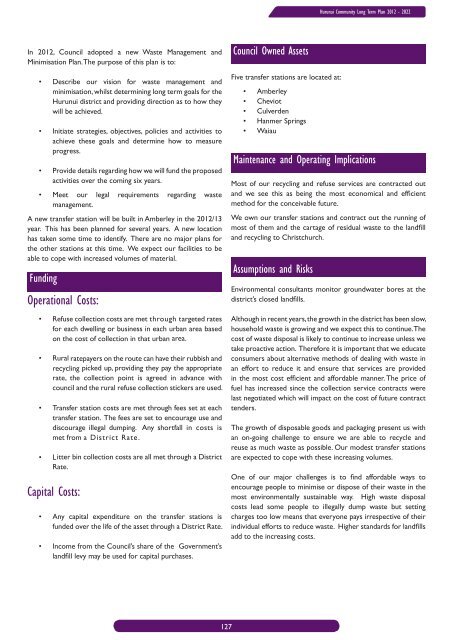Long Term Community Plan 2012-2022 - Hurunui District Council
Long Term Community Plan 2012-2022 - Hurunui District Council
Long Term Community Plan 2012-2022 - Hurunui District Council
Create successful ePaper yourself
Turn your PDF publications into a flip-book with our unique Google optimized e-Paper software.
<strong>Hurunui</strong> <strong>Community</strong> <strong>Long</strong> <strong>Term</strong> <strong>Plan</strong> <strong>2012</strong> - <strong>2022</strong><br />
In <strong>2012</strong>, <strong>Council</strong> adopted a new Waste Management and<br />
Minimisation <strong>Plan</strong>. The purpose of this plan is to:<br />
• Describe our vision for waste management and<br />
minimisation, whilst determining long term goals for the<br />
<strong>Hurunui</strong> district and providing direction as to how they<br />
will be achieved.<br />
• Initiate strategies, objectives, policies and activities to<br />
achieve these goals and determine how to measure<br />
progress.<br />
• Provide details regarding how we will fund the proposed<br />
activities over the coming six years.<br />
• Meet our legal requirements regarding waste<br />
management.<br />
A new transfer station will be built in Amberley in the <strong>2012</strong>/13<br />
year. This has been planned for several years. A new location<br />
has taken some time to identify. There are no major plans for<br />
the other stations at this time. We expect our facilities to be<br />
able to cope with increased volumes of material.<br />
Funding<br />
Operational Costs:<br />
• Refuse collection costs are met through targeted rates<br />
for each dwelling or business in each urban area based<br />
on the cost of collection in that urban area.<br />
• Rural ratepayers on the route can have their rubbish and<br />
recycling picked up, providing they pay the appropriate<br />
rate, the collection point is agreed in advance with<br />
council and the rural refuse collection stickers are used.<br />
• Transfer station costs are met through fees set at each<br />
transfer station. The fees are set to encourage use and<br />
discourage illegal dumping. Any shortfall in costs is<br />
met from a <strong>District</strong> Rate.<br />
• Litter bin collection costs are all met through a <strong>District</strong><br />
Rate.<br />
Capital Costs:<br />
• Any capital expenditure on the transfer stations is<br />
funded over the life of the asset through a <strong>District</strong> Rate.<br />
• Income from the <strong>Council</strong>’s share of the Government’s<br />
landfill levy may be used for capital purchases.<br />
<strong>Council</strong> Owned Assets<br />
Five transfer stations are located at:<br />
• Amberley<br />
• Cheviot<br />
• Culverden<br />
• Hanmer Springs<br />
• Waiau<br />
Maintenance and Operating Implications<br />
Most of our recycling and refuse services are contracted out<br />
and we see this as being the most economical and efficient<br />
method for the conceivable future.<br />
We own our transfer stations and contract out the running of<br />
most of them and the cartage of residual waste to the landfill<br />
and recycling to Christchurch.<br />
Assumptions and Risks<br />
Environmental consultants monitor groundwater bores at the<br />
district’s closed landfills.<br />
Although in recent years, the growth in the district has been slow,<br />
household waste is growing and we expect this to continue. The<br />
cost of waste disposal is likely to continue to increase unless we<br />
take proactive action. Therefore it is important that we educate<br />
consumers about alternative methods of dealing with waste in<br />
an effort to reduce it and ensure that services are provided<br />
in the most cost efficient and affordable manner. The price of<br />
fuel has increased since the collection service contracts were<br />
last negotiated which will impact on the cost of future contract<br />
tenders.<br />
The growth of disposable goods and packaging present us with<br />
an on-going challenge to ensure we are able to recycle and<br />
reuse as much waste as possible. Our modest transfer stations<br />
are expected to cope with these increasing volumes.<br />
One of our major challenges is to find affordable ways to<br />
encourage people to minimise or dispose of their waste in the<br />
most environmentally sustainable way. High waste disposal<br />
costs lead some people to illegally dump waste but setting<br />
charges too low means that everyone pays irrespective of their<br />
individual efforts to reduce waste. Higher standards for landfills<br />
add to the increasing costs.<br />
127

















